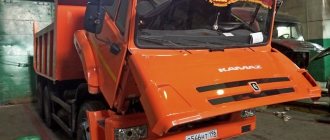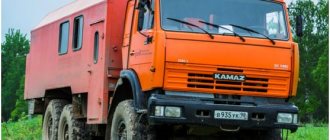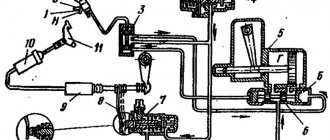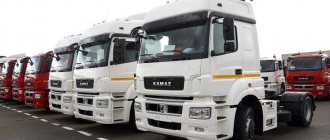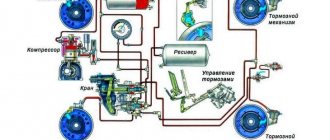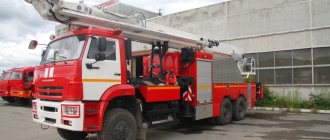KamAZ-4310 is an all-terrain truck from the Kama Automobile Plant, the main model. A significant part of these vehicles were produced for the Soviet Army.
The chassis marking is installed on the right side member of the frame at the rear (in the direction of travel). The identification number is entered on one line. There are restrictive marks at the beginning and end of the line.
The frame and cab identification number is punched respectively on the right side member in the front of the frame and on the inner panel of the cab front end and includes:
– designation of the frame (cabin) model (6 characters);
– year of manufacture code (1 character);
– serial production number of the frame (cabin) (7 characters).
The engine has its own information plate, which is installed on a specially treated area on the right side at the top in the front of the engine.
Figure 7 – Factory data plate
The marking containing the code of the base engine model (3 characters), the modification code of the base engine model (3 characters), the year of manufacture code (1 character) and the engine serial number (7 characters) is applied in two lines by impact on the surface of the cylinder block.
The plate contains:
– trademark of the manufacturer;
- engine model;
– additional data in various combinations depending on the engine model:
– A, B, C – numbers of UNECE regulations as amended;
– G, D, E – numbers of official approvals or certificates of conformity according to GOST R;
– conformity mark – E22.
Figure 8 – Engine data plate
The current legislation of the Russian Federation requires that information about the KAMAZ engine, frame and body be indicated. Where are they located and what do they contain?
Definitions and terms
General concepts
Base car model
– a car model on the basis of which its modifications are produced.
Modification
– a car model that differs from the base one in some respects (design and/or operational) that meet certain requirements and operating conditions.
Wheel formula
– a digital index expressing the total number of vehicle wheels and the number of driving wheels.
Busbar (single or double)
– the number of wheels (ramp) on the car axle on one side.
Environmental class
– a European standard that sets requirements for limiting the level of harmful substances in vehicle exhaust gases.
Number of sitting and sleeping places
– the number of seats in the cabin and places intended for sleeping of the driver and passenger.
Fuel tank volume
– an indicator characterizing the capacity of the vehicle’s fuel tank (in liters).
ABS (Anti-lock braking system)
– anti-lock braking system prevents the vehicle’s wheels from locking when braking.
ASR (Automatic Slip Regulation, Acceleration Slip Regulation, Anti-Slip Regulation)
– traction control system, designed to prevent slipping of the drive wheels.
EBS (Electronic Braking System)
– electronic braking system.
ESC (Electronic Stability Control) or ESP (Electronic Stability Program)
– is an addition to the EBS system and is designed to increase vehicle stability during such maneuvers as cornering and changing lanes (tipping over, swaying, deviation from a straight path and folding of the road train due to the high center of gravity and large mass). The system combines the functions of directional stability and rollover protection (RSC - Roll Stability Control).
ECAS
– air suspension control system. Provides convenient loading and unloading, smooth movement on uneven roads and regulates ground clearance.
Common Rail
– fuel supply system. The engine management system with a common rail fuel system determines the engine condition (rotation speed, throttle position (accelerator pedal), coolant temperature, etc.) from sensor signals and calculates the amount of cyclic flow, injection timing, fuel pressure using the system microcomputer management.
EGR
– exhaust gas recirculation system.
Mechanisms, units, devices and parts of KAMAZ vehicles
Engine
is a set of mechanisms and systems that convert the energy of fuel burning in the cylinders into mechanical energy.
Cabin
- this is a part of a vehicle designed to accommodate the driver and create conditions for the life of work.
Such conditions include:
Cabin of a KAMAZ vehicle
– cabover, all-metal, frame type, located above the engine, tilts forward, three-seater or two-seater, with one or two berths, depending on the model and equipment of the car. The design of the vehicles provides for a hydraulic cabin lift (some versions have an electric drive).
Car plate for export
The plate is installed on the right side panel of the cab in the door opening.
- name of the manufacturer;
- e - European approval;
- d - the distinctive number or letters of the country which has granted EEC type approval;
- f - EEC type approval number;
- identification number including:
- XTC – manufacturer code;
- a - conventional code of the car model in accordance with the technical specifications for the car, consisting of six characters;
- b — year of manufacture code (1 character);
- с — serial number of the car (7 characters).
Acceptable parameters of masses permitted for registration:
- m* — total vehicle weight;
- m1* — total weight of the road train (for tractors);
- P1* - permissible weight on the front axle;
- P2* - permissible mass on the second axle;
- P3* - permissible weight on the third axle;
- P4* - permissible mass on the fourth axle;
- manufacturer's trademark.
According to Regulation (EU) 19/2011, the letter "T" is added as a suffix to the maximum load on each axle that is part of that axle group (tandem).
Mass parameters technically permissible by the design:
- m is the total weight of the vehicle allowed by the design;
- m1 is the total weight of the road train (for tractors), permissible by the design;
- P1 is the weight permissible by the design on the front axle;
- P2 is the mass permissible by the design on the second axis;
- P3 is the weight permissible by the design on the third axle;
- P4 is the weight permissible by the design on the fourth axle.
- g — engine serial number;
- k — engine model;
- n is the useful engine power.
Vehicle plate
The vehicle manufacturer's plate is installed in the right door opening.
- name of the manufacturer;
- identification number including:
- XTC—manufacturer code;
- a - conventional car model code, consisting of six characters;
- b — year of manufacture code (1 character);
- с — serial production number of the vehicle (7 characters);
Features of the location of engine and frame numbers
The vehicle identification number is always located on the right side and in the rear, or more precisely, in the side member of the car frame. In this case, the KamAZ frame number can only be applied in the direction of travel. Restrictive signs must be placed on both sides.
Fact! In this case, you need to know where the frame number on KamAZ is located. This code combination is located on the right side member at the front of the car frame. The location of the cab number on KamAZ will be different: the inner panel of the front part of the cab.
The following information is required:
- vehicle frame or cabin model (6 characters);
- one digit indicating the year the car was produced;
- number combination of the frame or cabin (7 digits), which determines the date and product when the machine was released.
You also need to know where the engine number is located on KamAZ. The table with designations is installed on a specially treated area, or rather, in front of the power unit and always on the right side in the upper part.
In this case, indicate the following information about the power unit:
- code of the base motor that was originally installed;
- code that determines the version of the power unit;
- number identifying the year of manufacture of the engine;
- serial number combination.
Information is entered in 2 lines. The impact method is used for application, as this guarantees high-quality punching of numbers. In this case, the information is applied to the cylinder block.
The code combination is punched in certain areas in accordance with the vehicle layout and legal regulations. You can also read about Transmissions on KAMAZ.
What data is indicated?
A nameplate is installed on the right side of the car cabin (usually in the door opening) indicating the following information:
- data about the automobile plant, encrypted in the form of a code;
- index, which is a conventional code combination of the car model and consists of six characters, with the vehicle version indicated in the last place;
- one digit corresponding to the year of manufacture of the car;
- code combination about the car associated with the serial number at release (indicate 7 characters).
The table also indicates the following data:
- sign and number confirming the high quality of the manufactured vehicle;
- possible load permitted taking into account current safety regulations;
- engine number on a KamAZ vehicle, which includes 7 digits;
- motor model;
- power of the power unit (only the useful indicator is taken into account).
Important! Basic information is indicated in the cab number in KamAZ. Moreover, each digit has a special meaning, which is taken into account when compiling code combinations. However, to comply with standards, not only the frame number on KamAZ is important. The necessary information can be found on other parts of the vehicle, and the code combination always contains basic information about the car and a specific unit that is important for the technical performance of the car.
At the same time, the KamAZ chassis number does not indicate the following information, which is indicated only on the main plate:
- maximum possible vehicle weight;
- permitted mass that falls on the axles: front, second, third, fourth.
Factory data
Information about the manufacturer and characteristics of the machine can be found in the right door opening. At the top left of the plaque are:
- trademark and factory code (XTC);
- a - six-digit code of the car model;
- b - year of manufacture, indicated by one Latin letter;
- c - serial number of 7 digits.
On the right is the PCT conformity mark, which means that the car has passed GOST R certification. Below it is the “vehicle type approval” code. The max. is indicated next to it. load on the fifth wheel coupling (only for tractors operating with semi-trailers).
At the bottom left, in the outlined area, are:
- in the first two lines marked “kg” - the maximum weight of the car, self-propelled vehicle;
- after that, also in kg, is the maximum mass that can act on the front (1), second (2), third (3), fourth (4) axles.
Engine data is written under the KAMAZ sign:
- seven-digit serial number;
- model;
- useful power (net).
The vehicle's export plate is located in the same place as the manufacturer's data plate. The data labeling is identical, but is presented in the language specified in the supply agreement. Above the line with the model code are additionally indicated:
- European approval;
- a number/letter indicating the country that issued the EEC type approval;
- code for this statement.
Engine designation
A plate with information about the device is fixed on the cylinder block at the top right of the engine.
It indicates:
- manufacturer's trademark;
- unit model in ten characters;
- six-digit engine number;
- four-digit release date (month, year);
- UNECE and PCT certification marks of conformity.
The engine model affects the application of additional data, which is written in three columns:
- 1 - numbers of rules of the UN Economic Commission for Europe as amended;
- 2 - ciphers of. approvals or certificates of conformity according to the State Standard of the Russian Federation 50460-92;
- 3 — model of the high pressure fuel pump (HPFP).
The serial number of the unit and the production date are driven into the housing. The model can be embossed or applied photochemically.
Frame and body codes
Data about the frame is applied by impact to the side member in the direction of movement of the machine. Information about the cabin is on the interior panel of its front part. The codes are deciphered:
- the first six digits are the model;
- the seventh letter is the year of manufacture;
- the last seven digits are the production number.
The importance of labeling
The need to record data on a truck is established by GOST R51980-2002, which regulates the labeling of vehicles. According to it, the manufacturer's data plate is used to identify the machine.
The car frame code is required to register a car with the traffic police and obtain license plates. Often, the markings of older models produced before 2004 wear off due to natural reasons.
The State Traffic Inspectorate does not have many questions regarding old rental cars. The abrasion of signs on new KAMAZ vehicles is treated with suspicion and an examination is carried out to determine fraudulent actions.
When purchasing, it is important to check the presence of codes and plates and compare them with the documentation for the car.
In the Russian Federation, the KamAZ number is indicated on a vehicle of a certain brand, as this complies with the requirements of current legislation. Digital designations are applied taking into account basic data about the vehicle and established requirements, therefore, general rules are taken into account when informing car owners.
